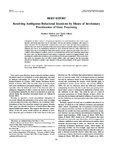Resolving ambiguous behavioral intentions by means of involuntary prioritization of gaze processing.
| dc.contributor.author | Hudson, Matthew | |
| dc.contributor.author | Jellema, T | |
| dc.date.accessioned | 2021-08-20T17:13:46Z | |
| dc.date.available | 2021-08-20T17:13:46Z | |
| dc.date.issued | 2011-06 | |
| dc.identifier.issn | 1528-3542 | |
| dc.identifier.issn | 1931-1516 | |
| dc.identifier.uri | http://hdl.handle.net/10026.1/17636 | |
| dc.description.abstract |
Anticipation of others' actions is of paramount importance in social interactions. Cues such as gaze direction and facial expressions can be informative, but can also produce ambiguity with respect to others' intentions. We investigated the combined effect of an actor's gaze and expression on judgments made by observers about the end-point of the actor's head rotation toward the observer. Expressions of approach gave rise to an unambiguous intention to move toward the observer, while expressions of avoidance gave rise to an ambiguous behavioral intention (as the expression and motion cues were in conflict). In the ambiguous condition, observers overestimated how far the actor's head had rotated when the actor's gaze was directed ahead of head rotation (compared to congruent or lagging behind). In the unambiguous condition the estimations were not influenced by the gaze manipulation. These results show that social cue integration does not follow simple additive rules, and suggests that the involuntary allocation of attention to another's gaze depends on the perceived ambiguity of the agent's behavioral intentions. | |
| dc.format.extent | 681-686 | |
| dc.format.medium | ||
| dc.language | en | |
| dc.language.iso | eng | |
| dc.publisher | American Psychological Association (APA) | |
| dc.subject | action anticipation | |
| dc.subject | representational momentum | |
| dc.subject | emotional expression | |
| dc.subject | approach avoidance | |
| dc.subject | Fuzzy Logic Model of Perception | |
| dc.title | Resolving ambiguous behavioral intentions by means of involuntary prioritization of gaze processing. | |
| dc.type | journal-article | |
| dc.type | Journal Article | |
| plymouth.author-url | https://www.webofscience.com/api/gateway?GWVersion=2&SrcApp=PARTNER_APP&SrcAuth=LinksAMR&KeyUT=WOS:000291711300023&DestLinkType=FullRecord&DestApp=ALL_WOS&UsrCustomerID=11bb513d99f797142bcfeffcc58ea008 | |
| plymouth.issue | 3 | |
| plymouth.volume | 11 | |
| plymouth.publication-status | Published online | |
| plymouth.journal | Emotion | |
| dc.identifier.doi | 10.1037/a0023264 | |
| plymouth.organisational-group | /Plymouth | |
| plymouth.organisational-group | /Plymouth/Faculty of Health | |
| plymouth.organisational-group | /Plymouth/Faculty of Health/School of Psychology | |
| plymouth.organisational-group | /Plymouth/REF 2021 Researchers by UoA | |
| plymouth.organisational-group | /Plymouth/REF 2021 Researchers by UoA/UoA04 Psychology, Psychiatry and Neuroscience | |
| plymouth.organisational-group | /Plymouth/Users by role | |
| plymouth.organisational-group | /Plymouth/Users by role/Academics | |
| dc.publisher.place | United States | |
| dc.identifier.eissn | 1931-1516 | |
| dc.rights.embargoperiod | Not known | |
| rioxxterms.versionofrecord | 10.1037/a0023264 | |
| rioxxterms.licenseref.uri | http://www.rioxx.net/licenses/all-rights-reserved | |
| rioxxterms.type | Journal Article/Review |


